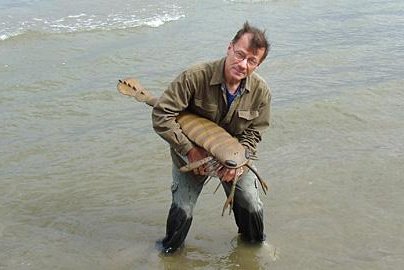Sam Ciurca, a curator at Yale's Department of Invertebrate Paleontology, takes a model of a pterygotid into the ocean surf. (YaleNews)
NEW HAVEN, Conn., July 10 (UPI) -- Scientists once believed ancient arthropods known as the sea scorpions -- or more formally, pterygotid eurypterids -- were the preeminent predators of the ocean shallows.
And while the creature was the largest ever arthropod (a group that includes lobsters and insects), measuring 6.5 feet long and armed with claws the size of tennis rackets, new evidence suggests it wasn't quite as scary as its name and description let on. The reason: it had pretty bad eyesight.
In a recent study, paleontologists at Yale reexamined the eyes of several pterygotids specimens and concluded that ancient creature likely had rather poor eyesight. It's layered lenses resembled those of today's horseshoe crab, likely good enough only for feeling around the ocean bottom at night for helpless prey.
The findings are detailed in the latest issue of the journal journal Biology Letters.
"These things were almost certainly still predators of some kind, but the imagined notion that they were swimming around terrorizing anything that looked edible is probably an exaggeration," explained Derek Briggs, a paleontologist at Yale and co-author of the new study.
The eyesight news comes not long after scientists suggested the ancient sea scorpions' claws were likely not strong enough to take on hard bodied prey
"The evidence suggests they ate soft objects that they were capable of shredding," said researcher Richard Laub, who studied the creature's claws at the Buffalo Museum of Science.
Still, Derek Briggs -- Yale scientist and co-author of the new eyesight study -- says you wouldn't have wanted to step on one.
"If you went swimming at night or in dark or murky waters and got your foot near the bottom, it might be sitting there waiting for you."















